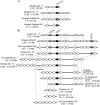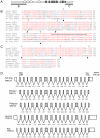Evolution of vertebrate transient receptor potential vanilloid 3 channels: opposite temperature sensitivity between mammals and western clawed frogs
- PMID: 21490957
- PMCID: PMC3072374
- DOI: 10.1371/journal.pgen.1002041
Evolution of vertebrate transient receptor potential vanilloid 3 channels: opposite temperature sensitivity between mammals and western clawed frogs
Abstract
Transient Receptor Potential (TRP) channels serve as temperature receptors in a wide variety of animals and must have played crucial roles in thermal adaptation. The TRP vanilloid (TRPV) subfamily contains several temperature receptors with different temperature sensitivities. The TRPV3 channel is known to be highly expressed in skin, where it is activated by warm temperatures and serves as a sensor to detect ambient temperatures near the body temperature of homeothermic animals such as mammals. Here we performed comprehensive comparative analyses of the TRPV subfamily in order to understand the evolutionary process; we identified novel TRPV genes and also characterized the evolutionary flexibility of TRPV3 during vertebrate evolution. We cloned the TRPV3 channel from the western clawed frog Xenopus tropicalis to understand the functional evolution of the TRPV3 channel. The amino acid sequences of the N- and C-terminal regions of the TRPV3 channel were highly diversified from those of other terrestrial vertebrate TRPV3 channels, although central portions were well conserved. In a heterologous expression system, several mammalian TRPV3 agonists did not activate the TRPV3 channel of the western clawed frog. Moreover, the frog TRPV3 channel did not respond to heat stimuli, instead it was activated by cold temperatures. Temperature thresholds for activation were about 16 °C, slightly below the lower temperature limit for the western clawed frog. Given that the TRPV3 channel is expressed in skin, its likely role is to detect noxious cold temperatures. Thus, the western clawed frog and mammals acquired opposite temperature sensitivity of the TRPV3 channel in order to detect environmental temperatures suitable for their respective species, indicating that temperature receptors can dynamically change properties to adapt to different thermal environments during evolution.
Conflict of interest statement
The authors have declared that no competing interests exist.
Figures







Similar articles
-
The Xenopus tropicalis orthologue of TRPV3 is heat sensitive.J Gen Physiol. 2015 Nov;146(5):411-21. doi: 10.1085/jgp.201511454. Epub 2015 Oct 12. J Gen Physiol. 2015. PMID: 26458875 Free PMC article.
-
Analysis of transient receptor potential ankyrin 1 (TRPA1) in frogs and lizards illuminates both nociceptive heat and chemical sensitivities and coexpression with TRP vanilloid 1 (TRPV1) in ancestral vertebrates.J Biol Chem. 2012 Aug 31;287(36):30743-54. doi: 10.1074/jbc.M112.362194. Epub 2012 Jul 12. J Biol Chem. 2012. PMID: 22791718 Free PMC article.
-
Evolution of thermoTRP ion channel homologs in vertebrates.Physiol Genomics. 2006 Nov 27;27(3):219-30. doi: 10.1152/physiolgenomics.00322.2005. Epub 2006 Aug 22. Physiol Genomics. 2006. PMID: 16926268
-
TRPV3: time to decipher a poorly understood family member!J Physiol. 2014 Jan 15;592(2):295-304. doi: 10.1113/jphysiol.2013.255968. Epub 2013 Jul 8. J Physiol. 2014. PMID: 23836684 Free PMC article. Review.
-
TRPV3 in skin thermosensation and temperature responses.J Physiol Sci. 2025 Mar;75(1):100005. doi: 10.1016/j.jphyss.2025.100005. Epub 2025 Jan 8. J Physiol Sci. 2025. PMID: 39837134 Free PMC article. Review.
Cited by
-
Evolutionary tuning of TRPA1 and TRPV1 thermal and chemical sensitivity in vertebrates.Temperature (Austin). 2017 Apr 7;4(2):141-152. doi: 10.1080/23328940.2017.1315478. eCollection 2017. Temperature (Austin). 2017. PMID: 28680930 Free PMC article. Review.
-
TRP channels: a missing bond in the entrainment mechanism of peripheral clocks throughout evolution.Temperature (Austin). 2015 Dec 30;2(4):522-34. doi: 10.1080/23328940.2015.1115803. eCollection 2015 Oct-Dec. Temperature (Austin). 2015. PMID: 27227072 Free PMC article. Review.
-
Homeostatic regulation of a motor circuit through temperature sensing rather than activity sensing.Curr Biol. 2025 May 19;35(10):2256-2265.e3. doi: 10.1016/j.cub.2025.03.054. Epub 2025 Apr 12. Curr Biol. 2025. PMID: 40220756
-
Thermosensation and longevity.J Comp Physiol A Neuroethol Sens Neural Behav Physiol. 2015 Sep;201(9):857-67. doi: 10.1007/s00359-015-1021-8. Epub 2015 Jun 23. J Comp Physiol A Neuroethol Sens Neural Behav Physiol. 2015. PMID: 26101089 Free PMC article. Review.
-
Evolutionary dynamics of metazoan TRP channels.Pflugers Arch. 2015 Oct;467(10):2043-53. doi: 10.1007/s00424-015-1705-5. Epub 2015 Apr 1. Pflugers Arch. 2015. PMID: 25823501 Review.
References
-
- Benham CD, Gunthorpe MJ, Davis JB. TRPV channels as temperature sensors. Cell Calcium. 2003;33:479–487. - PubMed
-
- Dhaka A, Viswanath V, Patapoutian A. TRP ion channels and temperature sensation. Annu Rev Neurosci. 2006;29:135–161. - PubMed
-
- Patapoutian A, Peier AM, Story GM, Viswanath V. ThermoTRP channels and beyond: mechanisms of temperature sensation. Nat Rev Neurosci. 2003;4:529–539. - PubMed
-
- Saito S, Shingai R. Evolution of thermoTRP ion channel homologs in vertebrates. Physiol Genomics. 2006;27:219–230. - PubMed
Publication types
MeSH terms
Substances
LinkOut - more resources
Full Text Sources

